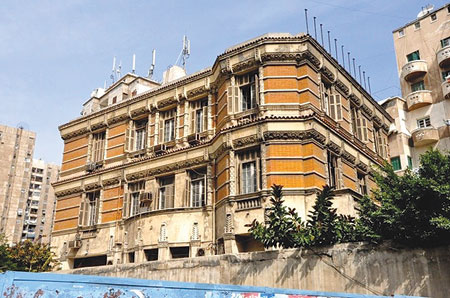Demolishing Villa Cicurel: Erasing Egypt’s Heritage is Unconstitutional

On October 1, 2016, residents of the city of Alexandria woke up to the news of the final demolition of heritage Villa Cicurel, after several attempts to bulldoze the villa within the past five years. The last of these attempts took place in June 2015 when the villa’s concrete pillars and structural foundations were tampered with at night, eventually causing the entire villa to be demolished last September. Egypt’s architectural heritage in particular, and cultural heritage in general, are going through a negligence crisis and deliberate distortion on the part of the government and heritage buildings owners. These buildings have been subject to a [cultural] carnage through deliberate and constant bulldozing by the “demolition mafia”.
These groups tamper with buildings of architectural style whose demolition is prohibited, divide their lands, and turn them into high-rise buildings. Villa Cicurel is a good example of what is happening to the architectural heritage. The villa was built in 1930 and designed by French architect Max Edrei in “Art Deco” style. The original owner of the villa (Cicurel) was a Jewish merchant that was appointed the dean of the Jewish community in Egypt in the 1940s. The villa was confiscated by the government in the following decade. In the 1970s, it became one of the presidential palaces. During the bread riot of 1977, former President Hosni Mubarak, who was at the time a vice-president, took refuge in the villa.[1]
Attempts to demolish the villa began after a decision issued by Prime Minister Kamal Ganzouri[2] to remove the villa from the city’s cultural and heritage site list, which includes heritage buildings protected from demolition or modifications. The decision to cross it out came in accordance with a court ruling issued by the Egyptian State Council, after the owner of the villa himself had appealed the decision to add the villa to that list. On May 9, 2012, the prime minister issued a new decision [revoking the previous one] instructing the executive authorities in Alexandria to stop issuing licenses to knock the villa down, unless there was a court ruling. The new decision was issued after the prime minister faced pressure and demands from activists and heritage advocates to stop the demolition of the villa since it is considered an irreplaceable masterpiece of great value, representing one of the most important eras of Alexandria and a symbol of its golden time of building and construction.
The demolition of Villa Cicurel brings to mind the problems raised by Law No. 144 of 2006, organizing heritage buildings. The law’s loopholes contributed to the destruction of many heritage buildings during the past years, in spite of the protection imposed by the Constitution on cultural heritage. Owners of these buildings exploited these loopholes by filing lawsuits to remove the building from the heritage conservation list.
The 2006 Law Adds More Conditions for the Protection of Heritage Buildings, in Violation of the Constitution
Articles 47 and 50 of the Egyptian Constitution stipulate that the state must preserve the various mainstays of Egyptian cultural identity. Under the Constitution, the state also has an obligation to protect and preserve the various contemporary architectural, literary, and artistic cultural treasure upon which encroachment is a crime punishable by law. Drafters of the Constitution expressed their conviction of the importance of this deeply-rooted historic heritage, which is the most significant component of natural and human capacity. They saw this heritage as the Egyptian people’s permanent embodiment of their experiences that enables them to face their present, and imagine their future.
However, the text of Article 2 of Law No. 144 of 2006 runs contrary to what was stipulated by the Constitution. In order to prohibit demolition, Article 2 decrees that it is not enough that the building be of a distinct architectural character, but it should also be associated with the national history or a historical figure, it should represent a historical era, or be a tourist attraction. Thus, the law has set conditions for heritage protection which are not stipulated in the Constitution. This constitutional violation in the law is a threat to hundreds of heritage buildings and structures in various governorates of Egypt, because most of these buildings were designed in different architectural styles. They were neither associated with historical figures or the national history, nor were they a tourist attraction.
Misinterpreting the Law
On the other hand, those interested in architectural heritage misinterpret and misapply the executive regulation of the law. Along with lawyers, they have tried to reduce the ongoing demolition of the Egyptian heritage by convincing judges of the Egyptian State Council that if a building is of distinguished architectural features, this makes it linked to a historical architectural era, or an architectural art school, such as the gothic style[3], the neoclassical[4] and other styles that prevailed in Egypt in a certain period. However, they faced difficulties in that the committees in charge of counting heritage buildings and structures protected from demolition misinterpreted the executive regulation of Law No. 144 of 2006.
The executive regulation of the law regulates the work of these committees in special internal records of each committee. These records categorize heritage buildings as follows.
Buildings and structures of distinctive architectural style;
Buildings and structures associated with national history;
Buildings and structures associated with a historical figure;
Buildings and structures that represent a historical era; and
Buildings and structures that are considered tourist attraction sites.
This confusion entailed that the counting committees send their internal records to the competent governor, who in turn sends them to the prime minister for ratification since they are decisions to count buildings and structures that must not to be demolished, in violation of the law. As a result, buildings of distinctive architectural style were classified without confirming whether one of the four other criteria has been met, rendering the files of these buildings incomplete and subjecting the ban on their demolition to the risk of nullification. A clear example of this is the Alexandria governorate which has witnessed the largest number of intentional or unintentional distortion, and destruction of registered or unregistered heritage buildings. Although Alexandria occupies the second place after Cairo in the number of registered heritage buildings, it occupies the first place as the governorate with the largest number of these buildings, and structures delisted from the list of buildings which must be preserved. Since 2008, 72 heritage buildings have been delisted in the governorate. The number of buildings registered as heritage buildings in Alexandria, under the following criteria stands at 1,135 buildings.
Out of those, 1,109 buildings have been registered under “distinctive architectural style”, 6 buildings under “associated with the national history”, 10 buildings under “associated with a historical figure”, and 8 buildings registered under “tourist attraction”. This means that there are over 1,000 buildings in Alexandria alone at risk of delisting, thus demolishment since they are only registered under “distinctive architectural style buildings”, contrary to the law.
The State’s Indifference to the Protection and Maintenance of Architectural Heritage
The state, represented by the Ministry of Culture and local administrations in the governorates, is unwilling and indifferent to the protection of heritage buildings. It is not doing its job as stipulated in the law and the Constitution to prevent the demolition and distortion of registered heritage buildings, and to provide maintenance thereto. Moreover, the state is shying away from inflicting penalties of imprisonment and fines on owners and contractors involved in the demolition of heritage buildings, letting this crime pass without any accountability.
This article is an edited translation from Arabic.
__________
[1] See: http://www.masress.com/elfagr/173938
[2] Prime minister’s Decision No. 86 of 2012 to delist the villa.



